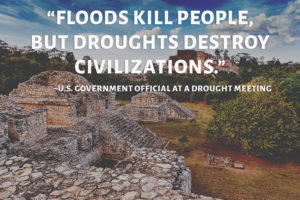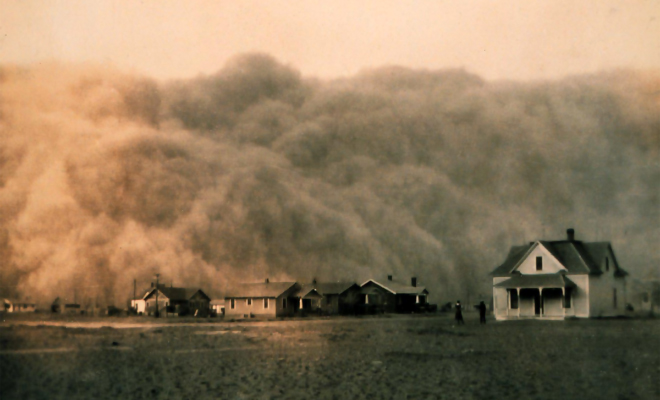A farm family walks through a Dust Bowl dust storm in Oklahoma, 1936. The 1930s Dust Bowl drought turned vast areas of the Great Plains into a “dust desert,” causing crop failure, mass migration, and illnesses like “dust pneumonia.”
If floods are the dramatic deluge, droughts are the slow-burning disaster.
Drought means an abnormally long period of low rainfall, leading to water shortages.
Climate change is disrupting rainfall patterns and raising temperatures, so many regions are seeing more frequent and intense droughts as well.
 Prolonged drought has wide-ranging impacts on health and society. An unknown U.S. government official at a drought meeting said, “Floods kill people, but droughts destroy civilizations.” That captures how drought’s effects, while less visually sudden than a flood, can be devastating and far-reaching.
Prolonged drought has wide-ranging impacts on health and society. An unknown U.S. government official at a drought meeting said, “Floods kill people, but droughts destroy civilizations.” That captures how drought’s effects, while less visually sudden than a flood, can be devastating and far-reaching.
THE 1930s DUST BOWL
One historical example is the American Dust Bowl of the 1930s. Over several years of severe drought and heat in the Great Plains, crops withered and the exposed topsoil literally blew away; gigantic dust storms blew across Oklahoma, Texas, Kansas, and many other states. These “black blizzards” buried farms and towns in dust.
Millions of people were displaced, as families gave up their desolate farms and migrated (many to California) in search of work and water.
Healthwise, the Dust Bowl drought caused a surge in respiratory illnesses. The dust was so pervasive and toxic that many developed a severe lung condition nicknamed “dust pneumonia.” Hundreds died from this condition, as constant dust inhalation led to lung infections and respiratory failure. In dusty areas, people also suffered from asthma, bronchitis, and eye irritation.
Severe droughts today
In the present day, severe droughts are affecting communities around the world, from East Africa to the American West. In developing regions, drought often means famine or food insecurity (if rains fail for multiple seasons, crops and livestock die, and people face starvation). In the United States, extended droughts in states like California have led to “megafires” (as dry vegetation provides abundant fuel for wildfires) and drinking water shortages in some towns. Health impacts of drought can be both direct and indirect:
Crop failures and livestock losses can lead to food shortages and higher food prices. Poor nutrition increases the risk of infections and developmental problems in children. In extreme cases, drought causes famine. A major driver of mortality in drought disasters is starvation, especially in vulnerable regions.
Less rainfall means water sources dry up, concentrating contaminants. Wells and ponds may become stagnant or polluted. People may have to use unsafe water, causing diarrheal diseases. Scarcity of water also makes hygiene (handwashing, bathing) difficult, raising infection risk. If clean water access is lost, drought can contribute to disease outbreaks like:
- Hepatitis A.
- Cholera.
- Dysentery (a generic term for bloody diarrheal illness that can be caused by many infectious organisms).
Drought in the Southwestern United States has even been linked to an increase in Valley Fever (a lung infection caused by inhaling Coccidioides fungal spores) because dry, dusty conditions help spread the fungus spores.
As seen in the Dust Bowl, dust storms become common when soil is parched. Blowing dust carries particulate matter that irritates lungs and can cause or worsen asthma, bronchitis, and other lung diseases.
Drought often coincides with wildfires (dry forests and grasslands ignite more easily), and wildfire smoke can blanket regions with harmful air pollution. In recent years, severe wildfire smoke during droughts has spiked respiratory clinic visits in western states.
Droughts frequently go together with heat waves (hotter temperatures increase evaporation and dry conditions, and high-pressure systems can cause both heat and lack of rain).
Extended periods of extreme heat can cause heat exhaustion and heat stroke, especially in outdoor workers and the elderly. Notably, extreme heat is one of the deadliest weather hazards, even more than hurricanes and floods.
For example, the European Heat Wave of 2003, which occurred during a summer drought, killed approximately 70,000 people across Europe. Many of those victims were older adults without air conditioning, who succumbed to heat stroke and dehydration.
We will delve deeper into a more recent example, and heat-specific health risks in the next module, but it’s important to recognize that heat often amplifies drought’s health problems.
Farmers and communities dependent on rainfall suffer economic losses during drought (crop failure, water rationing), which can lead to chronic stress, anxiety, and even a rise in suicide rates among farmers who lose their livelihoods.
The hopelessness and financial strain of an unending drought can be mentally devastating. Community cohesion can fray as people are forced to relocate or compete for scarce resources.
One striking statistic: During a multi-year drought in Australia, rural regions saw a measurable increase in depression and suicides among farmers.
Eco-anxiety and chronic stress about the future are increasingly noted in young people as well, especially when drought threatens their family’s way of life.
Droughts unfold slowly
Governments and health systems must not underestimate droughts. A severe drought tests public health in slow motion.
Droughts require:
- Long-term response like providing food aid.
- Drilling new wells or shipping water.
- Deploying mobile health clinics.
- Monitoring for malnutrition and disease outbreaks.
Drought preparedness might include developing early warning systems (to trigger relief efforts before famine sets in) and building more resilient water infrastructure (e.g. rainwater storage, drought-resistant crops).
As climate change continues, regions that relied on predictable seasonal rains are finding those rains less reliable, so drought preparedness and adaptation (like efficient irrigation, drought planning in hospitals, etc.) is a growing priority.
Question
Which of the following health outcomes is commonly associated with severe droughts, as opposed to floods?
Droughts often lead to dust storms and wildfires, which worsen air quality and cause respiratory problems (e.g. asthma, “dust pneumonia”).
The other options are typically associated with floods or hurricanes rather than droughts:
- Cholera outbreaks require water contamination (more likely in floods).
- Build collapse and acute trauma are more likely in hurricanes.
- A surge in acute injuries from collapsing infrastructure happens in fast disasters like storms/earthquakes, not slow droughts.
- Vibrio wound infections have occurred in floodwaters (as after Hurricane Ian), not in dry conditions.
Climate change and heat impacts (preview)
 It’s worth noting that extreme heat waves are a form of weather extreme closely linked to climate change, so much so that we dedicate a separate module to heat-related health risks. Heat waves deserve special attention because heat is the leading cause of weather-related mortality in many regions. As global temperatures rise, episodes of intense heat are becoming more frequent, longer, and hotter.
It’s worth noting that extreme heat waves are a form of weather extreme closely linked to climate change, so much so that we dedicate a separate module to heat-related health risks. Heat waves deserve special attention because heat is the leading cause of weather-related mortality in many regions. As global temperatures rise, episodes of intense heat are becoming more frequent, longer, and hotter.
For example, Europe’s 2003 heat wave was unprecedented at the time and killed tens of thousands, and such deadly heat events have since occurred in:
- Russia (2010).
- India/Pakistan (2015).
- Western Europe (2022).
In the United States, recent heat waves have broken records from the Pacific Northwest (2021) to the Southwest (2023–present day) stressing the limits of power grids and emergency services.
- The body
- Chronic conditions
- Vulnerable populations
- Heat islands
During extreme heat, the body’s cooling mechanisms (sweating, radiating heat) can fail to keep up, leading to heat exhaustion or heat stroke, which can be rapidly fatal without treatment.
High heat puts extra strain on the cardiovascular system (triggering heart attacks and strokes) and can worsen air pollution (hot sunny days increase ozone smog), aggravating asthma and other lung diseases.
- The elderly may not sense heat or thermoregulate as well.
- People with chronic illnesses.
- Infants.
- Outdoor laborers and athletes.
- Those without access to air conditioning (often low-income and unhoused individuals).
There is also an environmental justice aspect to heat, as urban neighborhoods lacking green space can become heat “islands” much hotter than surrounding areas. These are often areas where marginalized communities live.
All these factors mean that heat waves can quietly claim hundreds or thousands of lives if proper precautions aren’t taken. The good news is that heat-related illness is largely preventable with awareness and interventions (cooling centers, hydration, outreach to vulnerable groups).
We will explore these strategies and the medical management of heat injuries in detail in the next module.
For now, remember that extreme heat is a climate hazard on par with storms and floods, and it’s getting worse.
Note
Stay tuned for Module 3: Climate Change and Heat Impacts, where we’ll deep-dive into heat stroke, heat stress, and how to protect patients and populations when the mercury soars.
Image credits
Unless otherwise noted, images are from Adobe Stock.

